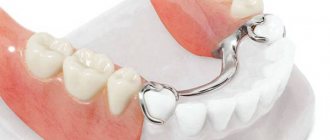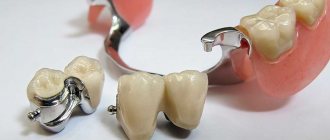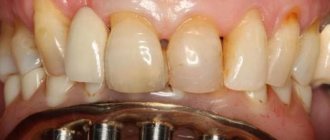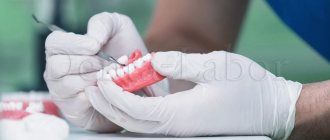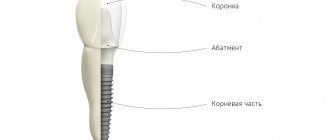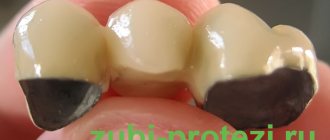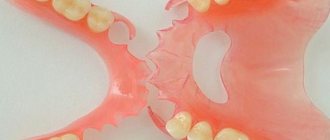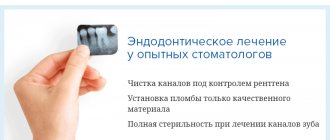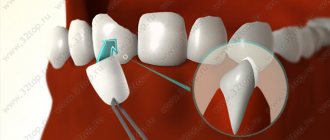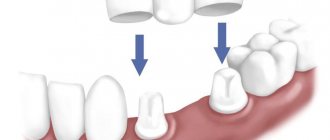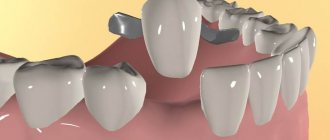What are the structures
A partial denture is used when teeth are partially missing (hence its name). The design consists of three elements:
- single base: this is a plate or base that is made of soft flexible or rigid plastic. Elastic materials are more comfortable and do not cause severe discomfort to the patient, especially during the first stages of use. However, their cost is quite high. As for hard plastics, they are more affordable, but many people have to “suffer” with them, because... It’s difficult to get used to such products - they rub, they are massive and hard,
- artificial crowns: they are soldered into the base. They are created mainly from plastic, which makes the entire structure lightweight and low in price,
- fastenings: most often these are ordinary clasps or hooks, less often - micro-locks (attachments) or telescopic crowns. Despite the fact that, according to the results of clinical studies and the practice of many orthodontists, the last two types have proven themselves to be the best (bone atrophy with this method of fixation occurs 1-2 times slower1), patients more often choose products with hooks, because . they have low cost.
On a note! Partial dentures are sometimes called partial dentures. But these are two different concepts and need to be distinguished. In particular, “partial removable” means that they replace only part of the dentition. And the concept of “partially removable” is used to designate those systems that can replace any number of teeth, but at the same time they are fixed in such a way that it will be difficult for the patient to remove them - nevertheless, this possibility remains. They are sometimes also called “conditionally removable”. This category includes prostheses on implants with screw fastening or removable structures with a locking fixation system.
Look at the photo to see what a partial denture looks like.
Indications and contraindications
The main indication or condition under which it is possible to install a prosthesis with a thin palatal bridge or without it at all is the absence of teeth, but not complete. The patient's mouth should retain at least 2-6 healthy teeth or their roots.
The following are considered contraindications to prosthetics with partial orthopedic structures without a palate:
- complete edentia,
- large amount of tartar and plaque: preliminary professional hygiene is required - ultrasonic cleaning and Air-Flow polishing,
- presence of dental diseases: caries, stomatitis, etc. – treatment is required first,
- absence of outer chewing teeth on both sides of the row at the same time,
- allergic reaction to prosthetic materials,
- intolerance to anesthesia: because Before prosthetics, it is often necessary to prepare the supporting teeth - grinding, strengthening root canals or installing fastening elements.
How do dentures stay in the mouth?
The devices are attached to the remaining natural teeth. In order to fix them, it is necessary that the patient has at least several living teeth in his mouth, located on both sides of the lost ones - they will act as a support. Those that survive must be healthy and strong enough, because including their condition will directly depend on their service life. After all, if the supports were initially weak, then they will quickly wear out and begin to wobble, and the structure installed on them will fail, begin to shift, will not hold well and will deform under any mechanical or chewing load.
BEST REMOVABLE DENTURE - 20,000 rub.
All manipulations for the manufacture, installation and fitting of the prosthesis, including impressions, are included.
Save RUB 10,000! >> Call now or request a call
Opening hours: 24 hours a day - seven days a week
In general, there are four main types of fixation of private systems:
- using hooks, which can be made of plastic - they are located at the base of the supporting teeth, have a white or pinkish color,
- using hooks made of metal - this option is usually used in clasp dentures. Often disables supporting teeth due to damage to the enamel,
- Locks or attachments are a two-way system: one part is located inside the prosthesis, the second is in the supporting teeth. It is important that the living teeth themselves are in excellent condition,
- telescopic system - in fact, such a prosthesis is similar to a bridge. But it allows the use of supporting teeth in a smaller number, plus it must be removed.
What types of dental prosthetics are best?
Every person who decides to undergo prosthetics, of course, is concerned with the pressing question: “What type of dental prosthetics is better?” Here you must first make a reservation about what kind of prosthetics we are talking about: the restoration of destroyed or damaged teeth or the replacement of a completely missing tooth (or several teeth). In the second case - when you need to restore a lost or extracted tooth - to the question “Which dental prosthetics should I choose?” There is only one answer: of course, implantation. However, here too you need to remember that there are pitfalls - for example, contraindications. As for the high price of dental implantation in Moscow, which scares off many patients and forces them to settle for less effective types of prosthetics, it is worth comparing the costs more carefully. The fact is that implants, if all installation rules are followed and with proper care, serve a person for a lifetime, and the crowns on them need to be changed no more often than once every ten, and sometimes fifteen years. As for, for example, bridges, the most popular alternative to implantation, they require replacement on average every five to seven years. In addition, the supporting teeth during bridge prosthetics tend to become loose, which also leads to their loss or destruction. In this state of affairs, the cost of implantation in the long term does not exceed the cost of bridge prosthetics.
However, in the case of prosthetics for partially, completely destroyed or lost teeth, your attending physician will tell you in detail how to choose the optimal treatment method for your specific situation. Remember that no conscientious doctor will remove a tooth and install an implant in its place if this tooth can be at least partially saved and restored using other types of prosthetics. Although an implant is the highest quality type of prosthetics, a native tooth, even if only the root remains, is still better.
Indications for installation
- partial or multiple edentia,
- absence of anterior incisors and/or chewing molars,
- the need for temporary prosthetics: for example, this situation may arise if the patient has not yet decided which restoration method is best for him to choose,
- the patient’s inability or unwillingness to install a fixed structure: for example, a bridge,
- the patient’s inability or unwillingness to install implants,
- temporary prosthetics for the period of implant healing in the jawbone,
- permanent restoration of several lost units using partially removable systems, when fixed prosthetics are not indicated, or the patient himself prefers a removable device to a fixed one.
How does the process of dental orthopedics work?
Regardless of the type of product, any dental element must be manufactured individually, taking into account anatomical features. Dentures are made in a laboratory.
- The patient must come for the first consultation, during which the doctor will help determine the choice of type of prosthetics, and may also prescribe additional tests.
- On the same day, an x-ray is taken to assess the condition of the oral cavity and bone tissue.
- Next, the preparatory process usually begins, which includes the necessary procedures to eliminate diseases of the teeth and gums.
- Then an impression of the teeth is taken, from which the technician makes a plaster mold, on the basis of which the entire structure is cast.
- Once the prosthesis is ready, it needs to be tried on, the dentist will look at how well the structure fits, and the patient will point out the shortcomings that need to be eliminated in the laboratory.
- The final stage will be the final installation of the orthopedic structure in its place. If this is a removable denture, then the dentist will help with installation the first time, but in the future the patient will no longer need additional help and will independently cope with its installation or removal.
What are the contraindications
Installation of dentures in the case of partial absence of teeth is not carried out if the patient is diagnosed with diseases of the oral mucosa in the acute stage (constant friction will only provoke the problem), as well as periodontitis and periodontal disease, which have led to the loosening of supporting teeth. However, there are options that can still be installed for such diseases - these are clasp structures, which, among other things, can have a splinting effect, preserve teeth from loosening, and correctly redistribute the load between sick and healthy ones.
You cannot install dentures if there is nothing to attach them to, that is, either there are no living teeth left, or they are in poor condition - for example, destroyed by a serious dental disease (deep caries, pulpitis or periodontitis). – in such teeth, as a rule, the nerve has been removed, and their walls are quite fragile.
Removable dental appliances are also not placed on patients with mental disorders, epilepsy and schizophrenia, since in such situations they can harm themselves and will also not be able to carry out high-quality oral hygiene. This will lead to destruction of both the supports and the prostheses themselves.
When choosing designs, all allergy sufferers should be careful, because... Some gingival base materials and metal fastening elements can cause the development of individual reactions, lead to discomfort and affect the deterioration of well-being. However, today a fairly wide selection of materials for the manufacture of prostheses allows each patient to choose the optimal design.
Partially removable dentures, especially for the upper jaw, are not recommended for patients whose professions involve publicity and constant tension of the facial muscles - singers, announcers, teachers, artists, lecturers.
YOUR QUESTIONS AND ANSWERS
QUESTION: Is it possible to make a new tooth if only one root remains from the old one? Or in such a situation, just remove the remains? Gera
ANSWER: If the root is preserved, then the tooth can be restored. There may be several options: use a pin or stump inlay for extension, followed by restoration of the supragingival part. The choice of method depends on the initial situation, so you can definitely say which one is suitable in your case after examining and taking a photo of the tooth.
QUESTION: After prosthetics for both jaws, I developed a problem in my upper jaw. I made a puller, the lower jaw fits well, but the upper jaw puts a lot of pressure on the attachment points. When I take off the prosthesis, the pain does not go away for another two days. I went to the doctor to have him loosen it, and now the prosthesis is falling off. Cornet
ANSWER: Dear Cornet, we are very sorry for your situation! First of all, it is important to understand that when installing removable structures, if you have not worn them before, there is an adaptation period. And in many cases it can be quite long and takes 2-3 months. During this time, you need to take out your removable denture only for cleaning after meals, but try to wear it the rest of the time so that the oral cavity adapts. In your situation, the compression of the gums at the attachment site could have been eased slightly, and over time the tissue would have gotten used to it. After the correction, the prosthesis began to fall out, perhaps due to the fact that the specialist was overzealous and removed a little more than necessary. Unfortunately, it is impossible to return the former boundaries of a removable denture - only to make a new one. Alternatively, you can try a special adhesive denture adhesive to improve bonding. It can be bought at a pharmacy.
1Belousov N.N. Time and sequence of stages of complex treatment of inflammatory periodontal diseases // Periodontology. – 2007. 2Razumnaya Z.V. Improving the technology of manufacturing dentures using CAD/CAM systems, 2012.
Author: Chorny S.V. (Thank you for your help in writing the article and the information provided)
Types of partial devices
The types of partially removable devices that orthopedic dentists can offer today are so diverse that any patient can find an acceptable option.
Acrylic
Acrylic are the most inexpensive products, the base and fastenings (clasps) of which are made of plastic (acrylic) in pink-red shades, the crowns are plastic. In some cases, clasps are made of metal, but this type of prosthesis should not be confused with a clasp prosthesis. On the upper jaw, the prosthesis covers the palate, while on the lower jaw it is fixed exclusively on the gum and supporting teeth.
The color of artificial gums and crowns can be matched closely to the natural shade of the enamel and soft tissues of the oral cavity. However, the materials of acrylic systems are inferior in aesthetics to other types of dentures, since plastic does not have the degree of transparency that is inherent in natural tissues of the oral cavity.
The use of crowns made of materials other than plastic in acrylic prostheses will be unjustified, since, for example, metal ceramics or zirconium dioxide, due to their significantly higher strength, will destroy the acrylic base, and the use of all-ceramic crowns will significantly increase the total cost of the restoration. In addition, the service life of an acrylic device is on average about 5 years, and crowns made of metal-ceramic or all-ceramic are intended for much longer use, however, when replacing the prosthesis, the crowns in it will also have to be changed.
Clasp
Clasp dentures, unlike other partial removable structures, have an additional important detail - this is a single metal arch or clasp. The top of the clasp is covered with plastic artificial gum. At the same time, the gums are much less massive than those of acrylic devices, since they perform an aesthetic function rather than a fastening function. The fasteners themselves are made of metal. These can be hooks that are fixed at the base of the supporting teeth, or special clasps (attachments), one part of which is located inside the prosthesis, the second in the living tooth. Devices with locks feel permanent in the mouth, they do not need to be removed frequently, and the locks themselves are not visible to others, but they are the only type of partial dentures that require cutting holes in the “supports” for installation.
In case of partial edentia, orthopedic dentists most often recommend clasp systems as the most convenient and reliable. At the same time, clasp structures have their drawbacks: metal hook-clasps that cling to the supporting teeth create unsatisfactory aesthetics. In addition, metal, constantly in contact with the surface of natural teeth, can damage the enamel.
Quattro Ti prostheses
There is a metal-free variety of clasp devices that are made from Dental D material - these are partial dentures of a new generation, called “Quattro Ti”. They have all the positive characteristics of clasp systems, but at the same time they are deprived of their significant disadvantages. The innovative material used to create them is very plastic, hypoallergenic, non-toxic, and does not cause galvanism. Quattro Ti are based on pinkish gums, artificial crowns, as well as hooks, which are made of base material. The aesthetic characteristics of the material make it possible to make the patient’s smile natural even if it is necessary to restore the front teeth.
Nylon
Nylon structures are considered one of the most comfortable because they are made from a very light and elastic material - nylon. They have three components: nylon artificial gum, nylon clasps and crowns.
Plastic is again used as a material for crowns. Nylon itself is considered a hypoallergenic material, but may still cause allergic reactions in some patients. This material has quite significant disadvantages - porosity, due to which it absorbs odors and dyes. Also, nylon cannot be repaired or adjusted, so its average service life is shorter than that of other “soft” prostheses. In addition, it has increased elasticity, which affects the durability of the system and the tight fit to the gums - after just a couple of years, the prosthesis no longer stays in the oral cavity.
Acry-Free systems
These are new generation prostheses made from material based on acrylic resins. Unlike ordinary acrylic, it is more plastic, does not contain toxic monomers and is superior to acrylic in density. Acry-Free (read as “Acry Free”) is a good solution for people with sensitive gums, for children and the elderly, and for athletes. Prostheses are distinguished by their lightness, aesthetics, and increased level of comfort.
Polyurethane
These are Russian analogues of nylon or other soft structures. Polyurethane is also an elastic hypoallergenic material with high strength and elasticity. Moreover, the cost of such prostheses is lower than the price of similar models. According to research results2, polyurethane systems are most effective for solving the problem of edentia in the elderly.
Immediate dentures
These are temporary structures created for that period of time until permanent ones are made for the patient. They are also used during implantation until the implants fuse with the bone tissue and cannot be loaded so as not to disrupt the healing process.
They are often called “butterfly prostheses” because they consist of crowns and a small part of plastic, from which peculiar “wings” extend - these are hooks that are used to engage the system with the lateral living teeth. They restore aesthetics well, but you won’t be able to fully chew vegetables, fruits and meat with them. When wearing them, you must observe dietary restrictions and eat mostly soft, pureed foods.
PROSTHETICS WITH 6 OSSTEM IMPLANTS FROM RUB 200,000.
Complex implantation Osstem (South Korea) with delayed loading after 4-6 months.
Call now or request a call
Dentures with locks
These are removable partial dentures without a palate that are secured to abutment teeth. And there are two possible options here. The first is small clasps (they were discussed earlier), which are fixed in the crowns of the prosthesis and the crowns of living teeth. The second option is to strengthen the supporting teeth with the help of special locks-inlays (most often used in cases of complete absence of teeth).
They are made of soft plastics, so they get used to quickly. The upper jaw does not overlap the palate. But when fixing them, it is important that at least four supporting chewing teeth remain in the oral cavity, and in good condition. Compared to classic models, they are more expensive, but the comfort during their operation is much higher. They belong to the category of conditionally removable, because You don’t need to remove them unnecessarily and on your own.
Key Features of the Newest Palateless Dentures
New materials and improved processing techniques for old ones (as well as modern1 technologies) have made it possible to improve the already known massive prostheses to such an extent that they do not contain a volumetric artificial palate (or almost none). The key characteristics of the new generation of “skyless” prosthetic structures, which distinguish them favorably from the previous one, are as follows:
- complete absence of palate in the upper jaw or the presence of a very thin bridge that is less noticeable,
- lightness and comfort to wear,
- They replace only teeth and a small part of the gums.
Scientists conducted a study in which several hundred people with removable dentures covering the roof of their mouth participated. The results showed that about 70% of respondents cannot eat and chew food properly, and just over 30% suffer from inflammatory processes in the soft tissues of the oral cavity. In addition, it has been proven that structures blocking the palate block about 40% of taste buds, which means the patient ceases to fully taste the food.
Manufacturing and installation stages
We have figured out what partial removable dentures are, now it’s time to find out how they are created and how their installation goes.
First stage: sanitation of the oral cavity (cleaning, treatment of teeth and gums if necessary).
Second stage: taking an impression and transferring it to a dental laboratory.
Third stage: production of the prosthesis in the laboratory. This takes from 2-3 days to a couple of weeks - it all depends on the complexity of the work and the workload of the laboratory. As for temporary solutions, for example, the immediate “butterfly” prosthesis, it can be manufactured in 1-2 hours.
Fourth stage: fitting and correction of the finished product. In this case, the adjustment is carried out in front of the patient, and not by a dental technician, but by an orthodontist (prosthetist).
Production time for removable devices
| View | Production time, in days |
| Clasp with hooks | 10–12 |
| Clasp on attachments | from 20 |
| Clasp dental crowns on telescopic crowns | from 20 |
| Nylon | 7–10 |
| Soft plastic | 5–10 |
| Plate and acrylic | 5–7 |
The table shows only the average time for dental technicians to complete work. Depending on the workload, the patient may be asked to complete the work much faster than the stated deadline. However, many dental laboratories operate using the “urgent order” system. Production time can be halved, but at the same time you will pay for urgency.
All about the benefits of partial removable devices
- affordable price,
- wide choice of designs and materials,
- the possibility of prosthetics without turning the supporting teeth,
- minimal time for dental restoration,
- restoration of teeth without the need for surgical interventions,
- the possibility of restoring teeth for patients with allergies to metals and plastics,
- restoring the aesthetics of a smile and returning the ability to chew food almost completely,
- a minimum number of contraindications: dentures can be installed at any age, you can choose an option for replacing milk units, for restoring teeth for elderly people who have weakened and inflamed gums. A solution can also be found for those who engage in traumatic sports.
REPROSTHETICS WITH ACRYLIC PROSTHETICS - RUB 200,000.
Re-prosthetics with an acrylic bridge on a metal frame (all included) up to 12 units.
Save RUR 30,000. Call now or request a call
Technology and methods of dental prosthetics
The technology of dental prosthetics does not stand still, it is constantly evolving, outdated ineffective methods are becoming a thing of the past, more and more advanced techniques and the most modern materials are appearing. Modern technologies and methods of dental prosthetics involve the widespread use of computers at all stages from diagnostics (taking 3D X-rays) to the manufacture and installation of structures. New technologies in dental prosthetics are, for example, a CAD/CAM system that allows the production of high-precision orthopedic structures using 3D computer models by sawing on a milling machine from high-strength ceramics, while just a few years ago crowns and other prosthetics were made by casting ceramics on metal frames. Thanks to the latest technologies and methods in dental prosthetics, today it is possible to make prosthetics in one visit to the doctor, when the design is made not by a technician in a laboratory, but by a special ultra-modern and high-speed machine, on which the doctor himself models the prosthesis.
Important information about disadvantages
- in case of insufficient fixation of the prosthesis, the use of fixing gels may be required: here it is important to remember that the quality of fixation of the structure can be impaired due to many factors - destruction and wear of supporting units, atrophy of the jaw bone, deformation of the product under mechanical loads, clogging of food debris under the elements of the system, poor cavity hygiene mouth and related dental diseases (for example, inflammation of the gums or caries in the cervical part of the tooth where the clasp is located),
As with any type of removable dentures, partially removable devices require getting used to: about how to get used to a partial denture and minimize the level of discomfort during its use, read more in the article about getting used to dentures.
- insufficient aesthetics: partially removable appliances may look quite aesthetically pleasing, but they are far from being able to recreate the natural appearance of teeth, such as, for example, permanent crowns with ceramic coating. In addition, clasps may be noticeable when opening the mouth if, for example, they were made of metal,
- the service life of removable structures is on average only 5-6 years: this is provided that you provide the products with high-quality care and handle them with care, and also carry out timely corrections and professional hygiene at the dentist,
- partially removable structures are not intended for increased chewing loads: they can become deformed due to the consumption of too hard or tough foods,
- Difficulties with nutrition: they block the palate, so the taste of food may change. In addition, due to insufficient fixation, chewing becomes difficult and sometimes even painful,
- removable products do not stop the atrophy of bone tissue in the area of missing teeth: each subsequent year of use of the “pullers” promotes bone tissue resorption (over the year, the volume of bone tissue is reduced by approximately 1 mm),
- the chewing load is distributed on the supporting units, which can lead to their premature destruction, wear and loosening: here the situation is similar to that which occurs when wearing fixed bridges - often after removing the structures you have to say goodbye to the supporting units, because they cannot be restored,
- Difficulty in maintenance: it can be especially difficult to properly clean metal fastening elements and hooks,
- structures with a palate on the upper jaw can cause disruption of the sensitivity of taste buds and the gag reflex, as well as impede diction and promote increased salivation,
- The enamel of the supporting units in the area of contact with the hooks may wear off.
Features of dental prosthetics
Each type of prosthetics has its own characteristics; let’s look briefly at each of them.
Prosthetics of anterior teeth
Requires great attention to the aesthetic side, as well as the shortest possible deadlines. This is due to the fact that few patients can afford to walk for a long time with an obvious aesthetic defect or a “hole” instead of a tooth. Also, prosthetics of the upper front teeth require the use of all-ceramic structures in order to avoid metal showing through the artificial enamel or exposing it in the gingival area.
Prosthetics of chewing teeth
Prosthetics of chewing teeth require more attention to the functional side of the issue. Here, metal-ceramics are acceptable, and in some cases even more preferable, since the strength of structures becomes more important than aesthetics. As for prosthetics on implants, it is advisable to use a two-stage technique, when the implant is first placed, and the crown is installed only after its complete osseointegration.
Prosthetics of the upper jaw teeth
If they are restored after removal, they may require a preliminary sinus lift. This is due to the close location of the maxillary sinuses (sinuses) near the roots of the upper lateral teeth. Sinus lifting is a type of bone grafting that allows you to lift the bottom of the maxillary sinus and fill the vacated space with bone tissue, which will be used to fix the titanium tooth root.
Which prostheses are best to choose?
Partial dentures – If this is the option you are planning to go with, then you need to understand which ones are best to choose. The table will help you decide.
| Selection criterion | Acrylic | Nylon | Clasp | Acri-Free and Quadrotti |
| Comfort level | Average at all stages of operation | High at first, then quickly deteriorates | Average, but takes a long time to get used to | High enough |
| Possibility of allergies | High, because the material contains a large amount of toxic monomers | Average, although the material is supposedly considered non-allergenic | Allergies may occur to metal fasteners | Minimal – the likelihood of developing allergic reactions is practically excluded |
| Wear resistance | High, but due to the lack of plasticity, structures often break | Under loads, the material bends and deforms | High. Metal allows the product to cope with any load | High. Do not stretch and rarely break (except for fastening elements and crowns) |
| Carrying out repairs | Possibly (depending on the breakdown) | Almost always not possible | Possibly (depending on the breakdown) | Possibly (depending on the breakdown) |
| Life time | About 5 years | About 2-3 years | About 7 years | About 5-7 years |
EXPERT OPINION
Samoilova Inna Valerievna
“For those patients who are deciding which partial denture is best for them, I recommend choosing designs made from new generation materials. These can be hypoallergenic “Acri Free” or “Quadrotti”, which are characterized by an increased level of comfort. But in any case, you need to proceed from the clinical situation. So, if a patient has periodontitis or periodontal disease, then the best solution for him to strengthen and temporarily preserve loose teeth will be splinting clasp devices. If the issue of finances is very pressing, and there are no contraindications, then we can also recommend budget options made from new generation acrylic.”
Comfortable dentures without a palate - types, features, reviews and prices
Article navigation
- Why is there a sky in a prosthesis?
- Key Features
- Advantages and disadvantages
- What materials are used
- Indications and contraindications
- Types of dentures without palate
- What are the alternatives?
- Which designs are better to choose?
- Rules for wearing and care
- How much do dentures cost?
Question for a specialist
Today, new dentures without a palate have appeared on the dental services market, which are characterized by higher wearing comfort. And compared to implants, they are also more affordable. Further in the article we will reveal the key features of removable and fixed modern dentures without a palate, which ones are better, and we will talk about the cost of these orthopedic structures.
Service life of prostheses: how long can they be worn?
A partial denture for the lower or upper jaw is best perceived as a temporary solution, because any of the systems discussed above has disadvantages that similar implant-supported models do not have. On average, the service life of “false jaws” will be limited to 3-5 years, but the plastic wears off in about 2-3 years.
And it is important to understand that service life will depend on several factors:
- type and type of device, materials used,
- health of supporting teeth,
- condition of the gums: do not forget that partial removable devices use not only teeth, but also mucous membranes as support,
- thorough hygienic care: if you do not perform oral hygiene and also do not clean the denture itself, then the service life declared by the manufacturer can be safely reduced several times. Do not forget that plastic and nylon easily absorb odors and dyes, bacterial plaque settles on the materials, and metal can oxidize under the influence of saliva,
- jawbone atrophy: it inevitably occurs regardless of which model you choose. With atrophy of the bone tissue under the prosthesis, the gums also sag, which means that the adherence to the mucous membrane becomes worse every day. The design often has to be adjusted.
Preparing teeth for prosthetics
Before the manufacture and installation of dentures, careful preparation for dental prosthetics must be carried out. First, any current oral problems such as tooth decay or gum disease such as periodontitis must be addressed. If some chronic diseases cannot be completely cured, it is necessary to put them into remission. Also, prosthetics may require preliminary orthodontic treatment, for example, if there is a severe malocclusion or there is not enough space to install an implant. Before aesthetic microprosthetics with veneers or lumineers, it is necessary to do whitening, and a procedure such as professional teeth cleaning will be required in any case. In addition to the above measures, an orthopedic consultation includes such preliminary steps as consulting a doctor, taking x-rays, drawing up a treatment plan and choosing the optimal type of prosthetics.
Useful information about hygiene rules
Caring for removable partial dentures should be thorough but gentle. To process artificial materials, purchase a brush with soft bristles and a non-abrasive toothpaste - brush artificial teeth twice a day, exactly the same amount as natural teeth. Be especially careful in areas where hooks and fastenings are located, but do so with due care to avoid damaging them. After each snack, be sure to remove the structure and rinse it under running warm water. Also clean and rinse the mouth itself after eating.
Be sure to do “spring cleaning” several times a week. To do this, purchase special tablets. According to the instructions, dissolve them in water and dip the products into the resulting solution so that they do not develop an unpleasant coating and a yellow tint.
Twice a year, be sure to visit the dentist so that the doctor can correct the system for the characteristics of the bite, examine the condition of the supporting units and gums, and carry out professional hygiene of the prosthesis itself and the oral cavity.
Maintenance of installed structures
Patients should remember that caring for artificial teeth is no different from caring for natural teeth. It is very important to brush your teeth daily with toothpaste and a brush, and remove food debris after each meal. With removable dentures, this is a mandatory condition, since food debris between the artificial structures and the gums can cause inflammation.
Read more about caring for installed dentures in the material “How to properly care for removable and fixed dentures so that they last as long as possible.”
In addition, you should not eat too hard foods - nuts, seeds, crackers. Artificial teeth can easily break from excessive pressure.
Alternative to partial removable structures
The optimal alternative to partial removable dentures can be confidently called dental implantation, when not only the crown is restored, but also the root, which is replaced by an implant. Implants can also be fitted with permanent crowns made of various materials (ceramic composite, metal ceramics, zirconium dioxide). This method of treatment is the most durable, comfortable and aesthetic, and does not require grinding of adjacent teeth, such as, for example, fixed bridge prosthetics - this is another alternative to partial removable devices.
To compare all possible options specifically for your clinical case, you need to consult a doctor and undergo the necessary diagnostics.
Rules for wearing and care
After prosthetics, the adaptation stage begins when the patient gets used to the new design. Although, it is fair to note that the absence of a massive palatal part significantly speeds up the addiction - for some people a couple of weeks is enough. To make this process go even faster, dentists recommend wearing the denture as long as possible, saying tongue twisters to train articulation, and not eating very hard foods so as not to injure the oral mucosa.
“The other day I finally got Quadrotti done, which I’m very happy about. Compared to the old acrylic, the addiction was almost unnoticeable. There was no nausea or lisp. I shouldn’t have saved the money last time; well, I would have paid right away for normal teeth and not suffered for a whole year.”
Oksana L., Ekaterinburg, review from gidpozubam.ru
Caring for orthopedic structures involves keeping them clean - rinse your mouth after every meal, regularly rinse the product with running water so that plaque and bacteria do not accumulate on the inside. Cleaning artificial crowns and plastic bases is carried out with a regular brush and low-abrasive paste. And for storage it is better to purchase a special case.
Estimated cost of structures
The cost of a partial removable denture will depend on the number of teeth that need to be restored and, of course, on the type of structure. For example, temporary immediate structures will cost you about 3-5 thousand rubles. Acrylic and nylon systems will cost from 15 thousand rubles. For clasp devices and prostheses of the new generation ("Acri Free" and "Quadrotti") you will have to pay even more - from 20-30 thousand rubles and more. The price of devices with attachments starts from 40 thousand rubles.
High-quality dental prosthetics
Unfortunately, the installation of dentures does not always go smoothly; sometimes incorrect dental prosthetics causes complications, and quite dangerous ones. However, it is necessary to clearly distinguish between discomfort, which invariably occurs after any serious dental intervention and is considered normal, and actual complications. If after the procedure for one, two or three days (depending on the type of prosthetics) there is slight bleeding in the area of the soft tissue incision, slight swelling or pain suppressed by painkillers, there is no need to sound the alarm, unless the pain is sharp and the bleeding not plentiful. If, within a few days after prosthetics, the tooth hurts very much, the bleeding does not stop, and the swelling does not subside, this means that the doctor made mistakes during dental prosthetics.
The most popular questions about partial removable devices
Do I need to remove them?
There is no need to take them off every day at night, especially during the adjustment period, which can take up to 2-3 weeks. However, for hygiene procedures and after eating, it is still better to remove the devices from the mouth in order to properly remove all food debris. The exception is conditionally removable systems with locking fastenings.
How to properly remove a partial denture?
Partially removable devices are created in such a way that each patient, if necessary, can independently remove them from the mouth (except for products with locks - it is better to entrust the process of removing them to a doctor). To remove them without damaging the supporting teeth and fastening elements, you need to act as delicately as possible. It's better to do this in front of a mirror. The pressure should be minimal.
Don't know what type of prosthetics to choose?
We will help in the selection, advise where to read more information and compare types of prosthetics.
Consultation with an orthopedic doctor in Moscow clinics is free! Call now or request a call
Working hours: from 9:00 to 21:00 - seven days a week
Where is the best place to store them?
It is important to remember that, for example, plastic products and metal structures deteriorate faster in a humid environment, which means if you decide to give your gums a rest and remove the devices, it is better to use special, well-ventilated containers for storing them.
Do devices need to be adjusted and how often should this be done?
After the initial installation, the product will have to be adjusted quite often. Depending on the individual characteristics of the patient, the number of missing teeth, and the condition of the jaw bone tissue in the first months, correction may be required up to 3-4 times. However, there is nothing to worry about, this process is natural, because with the installation of the prosthesis, your bite will gradually begin to change and be restored, which at first will seem uncomfortable.
After getting used to it, corrections will occur less frequently, but it will not be possible to completely abandon them, because atrophy of the jaw bone occurs under the structure. Due to the reduction in tissue volume without correction, a gap will form between the mucous membrane and the device, discomfort will appear, and the aesthetics of the smile will be disrupted.
What can you eat?
Such products are not intended for heavy chewing loads. To ensure that the structures retain their integrity and beautiful appearance longer, and also do not cause you physical discomfort, avoid eating excessively hard and hot foods, viscous foods, drinks and foods with dyes. Pre-cut hard, large pieces. In general, eat something that you feel comfortable chewing without pain or discomfort.
Can it be bleached?
Artificial teeth (the crowns themselves) are made of plastic, which absorbs odors and dyes well, so over time they may darken or turn yellow. To prevent this from happening, be sure to carefully and promptly care for them, because it is not possible to bleach them. The maximum that a doctor can do is to polish the surface of artificial materials, due to which they will become smoother and visually lighter.
When is it time to think about replacing structures?
Each partial removable denture has its own approximate service life, determined by the quality of the materials from which it is made. But it is important for the patient to understand that the durability of the restoration will depend not only on proper care of the material, but also on the general health of the oral cavity and the condition of the supporting teeth. It is best to determine when it is time to change the device, only a dentist can. That is why you should not neglect going to the doctor and preventive examinations 1-2 times a year.
Complex on 4 OSSTEM implants with delayed loading - 150,000 rubles.
Complex implantation Osstem (South Korea) with delayed loading after 4-6 months.
Doctor's work guarantee - up to 5 years (under an agreement on the provision of medical services) Call now or order a call
Opening hours: 24 hours a day - seven days a week
The latest dental prosthetics
People have been aware of the need for dental prosthetics since ancient times. The manufacture of dentures was reduced to crafts from seashells, animal bones, precious stones and even wood. But all this dental prosthetics was used only to mask the resulting defect, rather than to restore chewing function. For example, the products of ancient dental jewelers served primarily social purposes, and only then practical ones. The richest people of Ancient Rome could decorate their smiles with gold only to demonstrate their status to others.
In modern dentistry, dentures are an important part of dental treatment. The production of dentures does not stand still and constantly offers new technologies, expanding the possibilities of using various materials. It is difficult to imagine a modern person at business negotiations or at dinner with friends, giving those around him a toothless smile. Therefore, dentistry pays special attention to proper dental prosthetics, which belongs to a separate area - orthopedics. Accordingly, the doctor who performs dental prosthetics is called an orthopedist. In some clinics, dental treatment and prosthetics are performed by one doctor who specializes in orthopedics.
Difference from nylon models
Many patients are interested in which dentures are better - nylon or acrylic. Indeed, these materials are very common and constantly compete with each other.
They have the following differences:
- Acrylic. It has a solid structure and holds its given shape for a long time. It has a porous composition and is susceptible to the formation of microbes. Releases toxic components during prolonged wear. Can be fixed using special glue. The main advantage of such models is the affordable prices for acrylic dentures.
- Nylon. Soft material that adapts well to the oral cavity. May become deformed over time. Structures made from it are non-porous, so there is almost no plaque or odor on them. The material does not emit toxic substances. As a rule, removable products are fixed due to the suction effect; cream may not be used. Prices for nylon prostheses are quite high.
Prices for removable dentures
| Primary appointment (examination, consultation) with an orthopedic dentist | FOR FREE* |
| Repeated appointment (examination, consultation) with an orthopedic dentist | 100 rub. |
| Tooth restoration with a permanent inlay (CEREC method) | 18,000 rub. |
| Tooth restoration with an inlay, veneer, half-crown made of Imax material | 35,000 rub. |
| Tooth restoration with a temporary composite crown milled by laboratory method | 4,000 rub. |
| Tooth restoration with a temporary crown using the direct method | 2,500 rub. |
| Tooth restoration with a permanent crown (CEREC method) | 25,000 rub. |
| Tooth restoration with a permanent metal-free Imax crown with individual aesthetics (application method) | 35,000 rub. |
| Tooth restoration with a permanent metal-ceramic crown | 15,000 rub. |
| Tooth restoration with a permanent all-metal crown | 6,000 rub. |
| Restoring a tooth with a crown using a solid core inlay | 7,000 rub. |
| Restoring a tooth with a crown using a solid core inlay. Stump inlay made of zirconium dioxide | 15,000 rub. |
| Tooth restoration with a crown. Combined tooth. Metal-ceramic crown | 15,000 rub. |
| Tooth restoration with a permanent onlay (CEREC method) | 16,000 rub. |
| Restoring the integrity of the dentition with a fixed cantilever prosthesis made of acrylic with screw fixation | 150,000 rub. |
| Restoring the integrity of the dentition with a fixed cantilever prosthesis made of zirconium dioxide with screw fixation (without the cost of milling work) | 480,000 rub. |
| Selective grinding using a comp. "T-Scan" program | 5,000 rub. |
| Selective grinding of hard dental tissues (1 unit) | 200 rub. |
| Study on diagnostic jaw models with wax-up (Wax-Up) of the future orthopedic design for the purpose of planning preparation, aesthetics and function (1 unit) | 750 rub. |
| Bite correction using removable and non-removable orthopedic structures - mouthguard | 6,500 rub. |
| Clinical relining of removable dentures | 3,500 rub. |
| Relining a removable denture using a laboratory method. Complete update of the basis | 12,000 rub. |
| Repeated fixation of permanent orthopedic structures with temporary cement (1 unit) | 500 rub. |
| Repeated fixation of permanent orthopedic structures with permanent cement (1 unit) | 1,000 rub. |
| Repeated fixation with permanent cement of fixed orthopedic structures supported by implants (1 unit) | 1,200 rub. |
| Welding of the tooth. Welding the tooth into the prosthesis base | 2,000 rub. |
| Dental prosthetics using an implant with an individual titanium abutment (without the cost of a crown) | 12,000 rub. |
| Dental prosthetics using an implant with an individual zirconium abutment with a titanium base (without the cost of a crown) | 15,000 rub. |
| Dental prosthetics using an implant with a permanent metal-free crown made of zirconium dioxide with screw fixation | 40,000 rub. |
| Dental prosthetics using an implant with a permanent metal-free all-ceramic Imax crown with cement fixation on a zirconium abutment | 47,000 rub. |
| Dental prosthetics with complete removable plate dentures (1 jaw) | 35,000 rub. |
| Dental prosthetics with complete removable plate dentures (1 jaw) supported by implants on 4 locators | 80,000 rub. |
| Dental prosthetics with complete removable plate dentures (1 jaw) supported by implants on 4 ball-shaped abutments | 75,000 rub. |
| Dental prosthetics with complete removable plate dentures (1 jaw) supported by implants on a milled beam (without the cost of milling work) | 95,000 rub. |
| Dental prosthetics with complete removable plate dentures with reinforcement | 40,000 rub. |
| Prosthetics with removable clasp dentures with locking fixation (1 jaw) | 65,000 rub. |
| Prosthetics with removable clasp dentures with clasp fixation (1 jaw) | 45,000 rub. |
| Prosthetics with removable clasp dentures with telescopic fixation (1 jaw) | 75,000 rub. |
| Prosthetics with partial removable lamellar dentures (1 jaw) | 25,000 rub. |
| Prosthetics with partial removable plate dentures for temporary replacement of 1-3 missing teeth (immediate denture) | 15,000 rub. |
| Prosthetics with partial removable laminar dentures for the temporary replacement of 4-6 missing teeth (immediate denture) | 20,000 rub. |
| Prosthetics with partial removable plate dentures. Non-acrylic materials | 40,000 rub. |
| Removal of a fixed orthopedic structure (1 unit) | 1,000 rub. |
| Taking an impression with alginate mass | 1,000 rub. |
| Taking an impression with silicone mass | 2,000 rub. |
| Trephination of tooth, artificial crown | 500 rub. |
| Transcutaneous short-pulse electrical stimulation (TENS) | 12,500 rub. |
View all prices
* subject to completion of the prescribed treatment after consultation. Details from the administrator.
Advantages and disadvantages of clasp fastening
The pros and cons depend on what type of hooks are used.
- Metal hooks. Durable, securely fixed, and have sufficient rigidity to fully distribute the chewing load. Disadvantages: they can damage the surface of supporting teeth and are noticeable to others. Such hooks can rest on teeth covered with metal-ceramic crowns. In this case, reliable fixation will do without thinning the tooth enamel.
- Nylon hooks. Almost invisible, soft, comfortable. Disadvantages are also due to the softness of the material. Clasps of this type cannot distribute the load correctly; over time, the stability of the prosthesis decreases significantly.
The average cost of dentures in Moscow is from 9,000 rubles to 60,000 rubles.
The latest development - Vertex
Not long ago, the semi-rigid Vertex design was developed, which has already received many positive reviews. The following features can be highlighted:
- The material is characterized by high density and exceptional smoothness.
- The chewing load is evenly distributed on the upper and lower jaws of the product.
- The design is resistant to temperature changes and retains its shape even when eating very hot food.
- The prosthesis does not change color and does not absorb any odors.
- The product does not emit harmful substances and does not contain monomers.
- The models are very resistant to mechanical damage.
Vertex models look like this:
Acrylic
Partially removable
Partially removable
Telescopic and on implants
You can make the design in any of 12 shades:
Possible defects during operation and their repair
Most damage to acrylic dentures can be repaired without the expense of producing new structures.
Repair is required in situations such as:
- an artificial tooth is built in place of the removed supporting tooth;
- if an artificial dental organ falls out or is chipped, it is replaced with a new one;
- the lock that secures the prosthesis is attached to the supporting teeth has failed;
- the prosthesis does not fit well to the gum, and the base needs to be adjusted;
- the base is broken, it is repaired, or replaced if it is severely damaged.
Dentures have their own warranty period. Most often it is determined in one year.
Acrylic prosthesis Vertex
The Vertex prosthesis began to be used in dentistry quite recently. It has proven itself well and enjoys considerable popularity.
Dentists characterize the material of the Vertex product as very dense, easy to polish, does not change its original shade and does not absorb odors. Thanks to double pigmentation, the product has a natural pink color with veins.
The shrinkage of such prostheses is minimal, and they are completely non-toxic. Durability, reliability, moisture resistance and odorlessness are also clear advantages of such products.
The prosthesis is available in three color shades, allowing you to choose the most suitable one for each patient.
